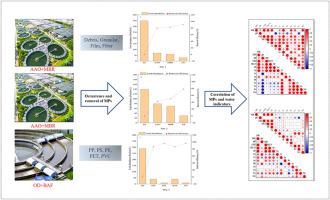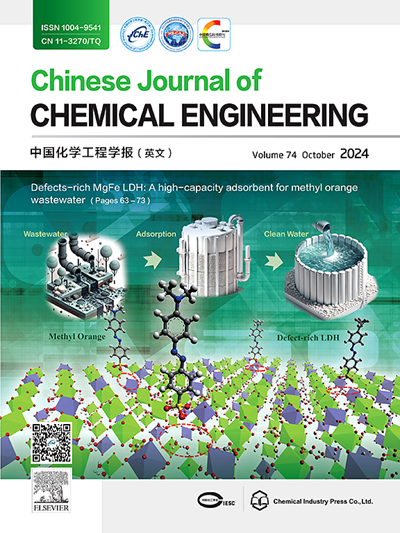Occurrence, characteristics and removal of microplastics in wastewater treatment plants with different treatment processes
IF 3.7
3区 工程技术
Q2 ENGINEERING, CHEMICAL
引用次数: 0
Abstract
The abundance of microplastics (MPs) in wastewater from three wastewater treatment plants (WWTPs) were determined in Hangzhou, Zhejiang Province, China. The MPs abundance was 140–350 particles per litre in the influent and 10–30 particles per litre in the effluent. Four shapes of MPs in the influent were observed, while mainly only debris was left in the effluent. The percentage of small (≤100 μm), medium (100–500 μm), and large-sized (≥500 μm) plastics in the raw leachate of the three WWTPs were 54.3%, 8.6%, and 37.1%, 28.6%, 64.3%, and 7.1%, and 41.4%, 24.1%, and 34.5%, respectively. Mainly only the size of ≤100 μm was left in the effluent of all. The removal efficiencies of MPs in a range of 78.6% to 96.6% were achieved. Polypropylene, polystyrene, polyethylene, polyethylene terephthalate and polyvinyl chloride were the main types and detected in all wastewater samples, accounting for over 75% of all types. The plastic components contained in different industrial wastewater were more complex. The distribution of MPs was significantly positively correlated with most conventional indicators such as chemical oxygen demead, ammonia nitrogen, and total phosphorus, but not with heavy metals. Similar wastewater, different treatment processes, or similar processes but different wastewater (industrial wastewater proportion varied) could all lead to differences in MPs removal. The MPs abundance measured in this experiment was similar to some previous studies, but relatively high. The three WWTPs can discharge up to 6.0 × 108–1.8 × 109 plastics of MPs per day, which poses potential ecological risks. This study indicates that the source control of MPs and optimizing the process design of existing WWTPs are crucial for preventing and controlling MPs pollution.

不同处理工艺污水处理厂中微塑料的发生、特征及去除
对浙江省杭州市3家污水处理厂废水中微塑料(MPs)的丰度进行了测定。在进水中,MPs丰度为每升140-350颗粒,在出水中为每升10-30颗粒。在进水中观察到四种形状的MPs,而在出水中主要只留下碎片。3个污水处理厂原渗滤液中小(≤100 μm)、中(100 - 500 μm)和大(≥500 μm)塑料的含量分别为54.3%、8.6%和37.1%、28.6%、64.3%和7.1%、41.4%、24.1%和34.5%。所有出水中主要只剩下粒径≤100 μm的颗粒。MPs的去除率在78.6% ~ 96.6%之间。聚丙烯、聚苯乙烯、聚乙烯、聚对苯二甲酸乙二醇酯和聚氯乙烯是所有废水样品中检测到的主要类型,占所有类型的75%以上。不同工业废水中所含的塑料组分更为复杂。MPs的分布与化学需氧量、氨氮、总磷等大多数常规指标呈显著正相关,与重金属含量无显著正相关。相似的废水,不同的处理工艺,或相似的工艺但不同的废水(工业废水比例不同)都可能导致MPs去除率的差异。本实验测量的MPs丰度与之前的一些研究相似,但相对较高。三个污水处理厂每天可排放6.0 × 108 ~ 1.8 × 109个塑料微粒,具有潜在的生态风险。研究表明,控制多磺酸盐的来源和优化现有污水处理厂的工艺设计对防治多磺酸盐污染至关重要。
本文章由计算机程序翻译,如有差异,请以英文原文为准。
求助全文
约1分钟内获得全文
求助全文
来源期刊

Chinese Journal of Chemical Engineering
工程技术-工程:化工
CiteScore
6.60
自引率
5.30%
发文量
4309
审稿时长
31 days
期刊介绍:
The Chinese Journal of Chemical Engineering (Monthly, started in 1982) is the official journal of the Chemical Industry and Engineering Society of China and published by the Chemical Industry Press Co. Ltd. The aim of the journal is to develop the international exchange of scientific and technical information in the field of chemical engineering. It publishes original research papers that cover the major advancements and achievements in chemical engineering in China as well as some articles from overseas contributors.
The topics of journal include chemical engineering, chemical technology, biochemical engineering, energy and environmental engineering and other relevant fields. Papers are published on the basis of their relevance to theoretical research, practical application or potential uses in the industry as Research Papers, Communications, Reviews and Perspectives. Prominent domestic and overseas chemical experts and scholars have been invited to form an International Advisory Board and the Editorial Committee. It enjoys recognition among Chinese academia and industry as a reliable source of information of what is going on in chemical engineering research, both domestic and abroad.
 求助内容:
求助内容: 应助结果提醒方式:
应助结果提醒方式:


